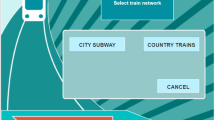Abstract
Artificial intelligence and data mining techniques offer a chance to make education tailored to every student. One of possible contributions of automated techniques is a selection of suitable problems for individual students based on previously collected data. To achieve this goal, we propose a model of problem solving times, which predicts how much time will a particular student need to solve a given problem. Our model is an analogy of the models used in the item response theory, but instead of probability of a correct answer, we model problem solving time. We also introduce a web-based problem solving tutor, which uses the model to make adaptive predictions and recommends problems of suitable difficulty. The system already collected extensive data on human problem solving. Using this dataset we evaluate the model and discuss an insight gained by an analysis of model parameters.
This work is supported by GAČR grant No. P202/10/0334.
Access this chapter
Tax calculation will be finalised at checkout
Purchases are for personal use only
Preview
Unable to display preview. Download preview PDF.
Similar content being viewed by others
References
Anderson, J.R., Boyle, C.F., Reiser, B.J.: Intelligent tutoring systems. Science 228(4698), 456–462 (1985)
Baker, F.B.: The basics of item response theory. University of Wisconsin (2001)
Csikszentmihalyi, M.: Beyond boredom and anxiety. Jossey-Bass (1975)
Csikszentmihalyi, M.: Flow: The psychology of optimal experience. HarperPerennial, New York (1991)
De Ayala, R.J.: The theory and practice of item response theory. The Guilford Press (2008)
Jarušek, P., Pelánek, R.: What determines difficulty of transport puzzles? In: Proc. of Florida Artificial Intelligence Research Society Conference, FLAIRS (2011)
Kantor, P.B., Ricci, F., Rokach, L., Shapira, B.: Recommender systems handbook. Springer, Heidelberg (2010)
Koedinger, K.R., Anderson, J.R., Hadley, W.H., Mark, M.A.: Intelligent tutoring goes to school in the big city. International Journal of Artificial Intelligence in Education 8(1), 30–43 (1997)
Koedinger, K.R., Corbett, A.T., Ritter, S., Shapiro, L.: Carnegie Learning’s Cognitive Tutor: Summary research results. White paper. Available from Carnegie Learning Inc., 1200 (2000)
Kotovsky, K., Hayes, J.R., Simon, H.A.: Why are some problems hard? Evidence from tower of Hanoi. Cognitive psychology 17(2), 248–294 (1985)
Kotovsky, K., Simon, H.A.: What Makes Some Problems Really Hard: Explorations in the Problem Space of Difficulty. Cognitive Psychology 22(2), 143–183 (1990)
Pelánek, R.: Difficulty rating of sudoku puzzles by a computational model. In: Proc. of Florida Artificial Intelligence Research Society Conference, FLAIRS (2011)
Pizlo, Z., Li, Z.: Solving combinatorial problems: The 15-puzzle. Memory and Cognition 33(6), 1069 (2005)
Simon, H.A., Newell, A.: Human problem solving. Prentice-Hall (1972)
Van der Linden, W.J.: A lognormal model for response times on test items. Journal of Educational and Behavioral Statistics 31(2), 181 (2006)
Van Der Linden, W.J.: Conceptual issues in response-time modeling. Journal of Educational Measurement 46(3), 247–272 (2009)
Vanlehn, K.: The behavior of tutoring systems. International Journal of Artificial Intelligence in Education 16(3), 227–265 (2006)
Author information
Authors and Affiliations
Editor information
Editors and Affiliations
Rights and permissions
Copyright information
© 2012 Springer-Verlag Berlin Heidelberg
About this paper
Cite this paper
Jarušek, P., Pelánek, R. (2012). Modeling and Predicting Students Problem Solving Times. In: Bieliková, M., Friedrich, G., Gottlob, G., Katzenbeisser, S., Turán, G. (eds) SOFSEM 2012: Theory and Practice of Computer Science. SOFSEM 2012. Lecture Notes in Computer Science, vol 7147. Springer, Berlin, Heidelberg. https://doi.org/10.1007/978-3-642-27660-6_52
Download citation
DOI: https://doi.org/10.1007/978-3-642-27660-6_52
Publisher Name: Springer, Berlin, Heidelberg
Print ISBN: 978-3-642-27659-0
Online ISBN: 978-3-642-27660-6
eBook Packages: Computer ScienceComputer Science (R0)




